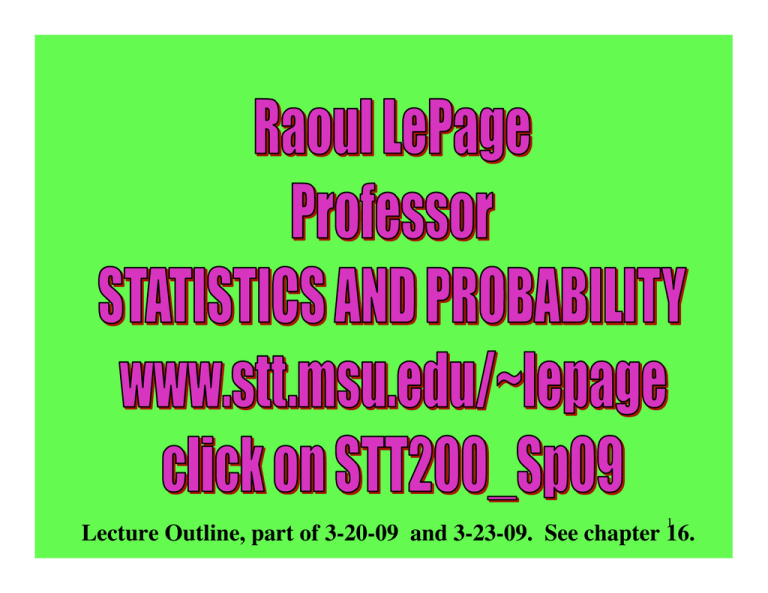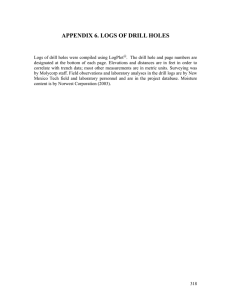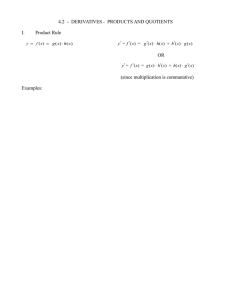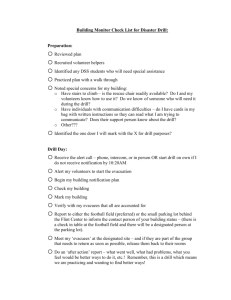Lecture Outline, part of 3-20-09 and 3-23-09. See... 1
advertisement

1 Lecture Outline, part of 3-20-09 and 3-23-09. See chapter 16. Chapter 16 2 3 4 5 6 7 8 total probability 0.2 0.2 0.3 0.1 0.1 0.05 0.05 1 2 P(oil) = 0.3 Cost to drill 130 Reward for oil 400 net return “just drill” -130 + 400 = 270 0.3 drill oil oil drill no oil 0.7 -130 + 000 = -130 no oil A random variable is just a numerical function 3 over the outcomes of a probability experiment. Definition of E X E X = sum of value times probability x p(x). Key properties E(a X + b) = a E(X) + b E(X + Y) = E(X) + E(Y) (always, if such exist) a. E(sum of 13 dice) = 13 E(one die) = 13(3.5). b. E(0.82 Ford US + Ford Germany - 20M) = 0.82 E(Ford US) + E(Ford Germany) - 20M 4 regardless of any possible dependence. 2 3 4 5 6 7 8 9 10 11 12 sum probability product 1/36 2/36 2/36 6/36 3/36 12/36 4/36 20/36 5/36 30/36 6/36 42/36 5/36 40/36 4/36 36/36 3/36 30/36 2/36 22/36 1/36 12/36 1 252/36 = 7 (3-15) of text 5 (3-17 of text) 2 3 4 5 6 7 8 total probability 0.2 0.2 0.3 0.1 0.1 0.05 0.05 1 product 0.4 0.6 1.2 0.5 0.6 0.35 0.4 4.05 6 P(oil) = 0.3 Cost to drill 130 Reward for oil 400 net return “just drill” -130 + 400 = 270 0.3 drill oil oil drill no oil 0.7 -130 + 000 = -130 no oil A random variable is just a numerical function 7 over the outcomes of a probability experiment. Expected return from policy “just drill” is the probability weighted average (NET) return E(NET) = (0.3) (270) + (0.7) (-130) = 81 - 91 = -10. net return from policy“just drill.” -130 + 400 = 270 0.3 drill oil oil drill no-oil 0.7 -130 + 0 = -130 no oil E(X) = -10 8 “costs” TEST 20 DRILL 130 OIL 400 0.3 0.7 A test costing 20 is available. This test has: P(test + | oil) = 0.9 P(test + | no-oil) = 0.4. oil no oil 0.9 0.1 + 0.4 0.6 + Is it worth 20 to test first? - 0.27 0.03 0.28 0.42 9 oil+ = -20 -130 + 400 = 250 0.27 oil- = -20 - 0 + 0 = - 20 .03 no oil+ = -20 -130 + 0 = -150 .28 no oil- = -20 - 0 + 0 = - 20 .42 total 1.00 67.5 - 0.6 - 42.0 - 8.4 16.5 E(NET) = .27 (250) - .03 (20) - .28 (150) - .42 (20) = 16.5 (for the “test first” policy). This average return is much preferred over the 10 E(NET) = -10 of the “just drill” policy. x p(x) 2 0.2 3 0.2 4 0.3 5 0.1 6 0.1 7 0.05 8 0.05 total 1.00 quantity terminology x p(x) x2 p(x) (x-4.05)2 p(x) 0.4 0.8 0.8405 0.6 1.8 0.2205 1.2 4.8 0.0005 0.5 2.5 0.09025 0.6 3.6 0.38025 0.35 2.45 0.435125 0.4 3.2 0.780125 4.05 19.15 2.7475 EX E X2 E (X - E X)2 mean (3-17) of text mean of squares variance = mean of sq dev s.d. = root(2.7474) = root(19.15 - 4.052) = 1.6576 11 Var(X) =def E (X - E X)2 =comp E (X2) - (E X)2 i.e. Var(X) is the expected square deviation of r.v. X from its own expectation. Caution: The computing formula (right above), although perfectly accurate mathematically, is sensitive to rounding errors. Key properties: Var(a X + b) = a2 Var(X) (b has no effect). sd(a X + b) = |a| sd(X). VAR(X + Y) = Var(X) + VAR(Y) if X ind of Y. 12 Random variables X, Y are INDEPENDENT if p(x, y) = p(x) p(y) for all possible values x, y. If random variables X, Y are INDEPENDENT E (X Y) = (E X) (E Y) echoing the above. Var( X + Y ) = Var( X ) + Var( Y ). 13 Venture one returns random variable X per $1 investment. This X is termed the “price relative.” This random X may in turn be reinvested in venture two which returns random random variable Y per $1 investment. The return from $1 invested at the outset is the product random variable XY. If INDEPENDENT, E( X Y ) = (E X) (E Y). 14 EXAMPLE: $1 X x 0.8 1.2 1.5 p(x) x p(x) 0.3 0.24 0.5 0.60 0.2 0.30 E(X) = 1.14 BUT YOU WILL NOT EARN 14%. Simply put, the average is not a reliable guide to real returns in the case of exponential growth. 15 EXAMPLE: $1 X x p(x) Loge[x] p(x) 0.8 0.3 -0.029073 1.2 0.5 0.039591 1.5 0.2 0.035218 E Loge[X] = 0.105311 e0.105311.. = 1.11106.. With INDEPENDENT plays your RANDOM return will compound at 11.1% not 14%. (more about this later in the course) 16 17 18 19 20 21





